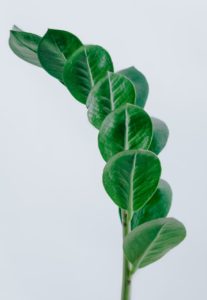Some links in the post are affiliate links and I get a commission from purchases made through some links found in the post.
The Zamioculcas Zamiifolia, also known as the ZZ plant, Zanzibar Gem, or just ZZ is a plant widely considered to be low-maintenance.
It requires low light and benefits from the tendency to forget watering by its owner.
By these standards, the ZZ plant is the perfect fit for someone just starting out with their first houseplant. They are great for the forgetful plant parent.
They are great even for seasoned houseplant veterans who take their green thumb status very seriously.
But what happens when your ZZ plant develops a wrinkled or withered stem?
Often coupled with leaves dropping, your zz plant will become wrinkled for two reasons, the first being your zz plant is underwatered and the other is that your zz plant is overwatered.
If your watering is correct, the wrinkled stem could just be due to old age.
Why does a ZZ Plant get a Wrinkled Stem?
 Aren’t plants amazing? Unlike humans that can tell you they’re experiencing illness, plants can’t voice their problems to you.
Aren’t plants amazing? Unlike humans that can tell you they’re experiencing illness, plants can’t voice their problems to you.
They can, however, show it on their leaves, stems (also called petioles), roots, and even the soil they are planted in.
A ZZ plant will often develop a wrinkled stem as a result of one of two extremes.
On the one hand they could be experiencing underwatering, and on the other end of the spectrum, they might be overwatered.
You will know which of the two cases you are dealing with by checking the leaves.
Yellowing leaves immediately indicate overwatering, as well as soil that is very moist and leaking water from the pot’s drainage holes.
Underwatering presents itself as dry, crumbly soil, that doesn’t stick to your finger when inserting it into the soil.
Leaves may have browned or turned slightly black and may feel crispy.
A third cause may very well just be an older stem dying naturally. In which case you’ll have to decide whether to remove the stem or try to fix it.
In the case of removing a dying stem, you will take a lot of stress away from your plant.
This is because it uses a lot of precious energy and resources to keep dying parts on the plant.
Sending nutrients to dead leaves, for example, will mean that once the dead leaf drops, your plant has lost resources essential to the survival of the still-healthy plant.
Fixing your ZZ plant is often worth the effort to restore the plant’s beauty and health.
ZZ plants store water in their rhizomes to make them drought tolerant. A gross lack of watering may lead to a wrinkled stem as the zz plant dehydrates and uses up its resources.
The obvious solution in this case would be to start watering your plant. But be warned it’s very easy to overwater an underwatered plant as it can get overwhelmed and essentially drown.
Here’s how you can reintroduce hydration the right way:
How to Save Your ZZ Plant When it is Underwatered
As mentioned above, an underwatered ZZ plant will usually present with dry soil and possible browning or blackening leaves.
If you haven’t watered in a very long time, like a month, then it’s time to let your plant have a drink! A thirsty ZZ plant is easy to fix:
1) Insert your finger into the soil
If no soil sticks to your finger when you pull it out, your plant is in dire need of watering.
If some soil sticks or is moist a little below the surface, you can water your plant a bit, but be careful not to overwater.
2) Fully water the plant
To properly water your ZZ and make sure its soil is saturated, take the plant over to a sink and water the plant until water escapes the drainage holes of the pot.
Now that the soil is saturated, place the plant in a medium light spot to help it drain further and soak up all the water it needs.
3) Keep an eye on it
Around two weeks after doing the previous step, you should redo the first step. Insert a finger into the soil and feel for moisture.
If the soil dries out too fast, you should water more often or move the plant to an area with less light or warmth.
Also if the soil stays moist for too long, move the plant to a warmer, more brightly lit area and see if it helps. If not, then you may be dealing with overwatering.
4) Propagation
If the plant continues to decline, it might be best to try to salvage what you have by propagating the plant.
In this way, you can still keep your ZZ and potentially multiply the plants. Additionally, you will have a fresh plant to start with.
If you are enjoying this article, check out our article on how can you prevent curled or wrinkled orchid leaves.
How to Save your ZZ Plant when it is Overwatered
An overwatered ZZ will present yellowing leaves which will possibly drop, as well as soil that stays moist.
This is especially easy to spot if you’ve recently watered the plant and its stem has wrinkled. Here’s how to fix that:
1) Repotting
Probably the best and quickest way to save your ZZ plant is by repotting. You can do this by carefully removing the plant from its current pot.
Prepare a new pot with soil that will drain well enough to ensure drainage but holds enough moisture that your plant doesn’t constantly wilt.
Succulent soil is perfect in this case as it is mixed with exactly those properties in mind. ZZ plants do behave like succulents, after all.
Once repotted, don’t saturate the soil like you normally would.
Instead, pour just a bit of water on the surface of the soil as a start, and then monitor the soil’s moisture with the finger test to determine an appropriate watering schedule.
2) Waiting between watering
If you aren’t concerned about an overwatered ZZ to the extent of risking root rot. Your next best step is to just wait a bit longer between watering the plant.
The finger test comes in handy here, too. Keep in mind that it is better to water more often in small amounts than shocking your plant with a massive soak once in a while, however.
3) Propagation
As with an underwatered plant, if it looks like your ZZ won’t make it, it might be best to cut your losses. A great way to save some of the plant is to propagate it.
Root rot can easily begin killing a plant in the case of overwatering. Even if you properly treat the plant by cutting dead roots, stems, and leaves off, the damage may already be done.
Propagation has the potential to create many new ZZ plants that can be cared for the right way.
Once they have established root systems and are ready to be planted.
Final Thoughts: How to Save your ZZ Plant with a Wrinkled Stem
ZZ plants are notorious for their ability to continue to thrive despite neglect at the hands of their plant parents.
They will show signs of unhappiness at their conditions, should they reach extremes.
While they are perfect for forgetful plant enthusiasts, an overeager approach may be just as harmful to the plant as a neglectful one.
Learning how to identify early on what may be causing your ZZ plant to develop wrinkly stems is essential.
It’s essental in saving your plant’s life by remedying the problem as soon as possible. Good luck!
Before you go, here are some more related articles I encourage you to read below to help solve more of your gardening issues:
How to Stop Your ZZ Plant Drooping

